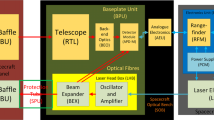Abstract
First generation spaceborne altimetric approaches are not well-suited to generating the few meter level horizontal resolution and decimeter accuracy vertical (range) resolution on the global scale desired by many in the Earth and planetary science communities. The present paper discusses the major technological impediments to achieving few meter transverse resolutions globally using conventional approaches and offers a feasible conceptual design which utilizes modest power kHz rate lasers, array detectors, photoncounting multi-channel timing receivers, and dual wedge optical scanners with transmitter point-ahead correction.
Zusammenfassung
Herkömmliche topographische Messsysteme lassen sich kaum auf satellitengestützte Anwendungen mit globaler Bedeckung hochskalieren, wenn dennoch horizontale Auflösungen von einigen Metern und vertikale Auflösungen im Dezimeterbereich vorgegeben sind. Derartige Eckdaten werden aber vielfach von Erdbeobachtern und Planetenforschern gefordert. Der vorliegende Artikel beleuchtet die wesentlichen technologischen Hindernisse, die eine Skalierung konventioneller Methoden unmöglich macht, und stellt gleichzeitig einen gangbaren Weg vor, der auf folgenden Komponenten beruht: Lasern mit moderaten Ausgangsleistungen und Pulswiederholraten im Kilohertzbereich, Detektorfeldern im Photonenzählbetrieb mit zeitlich gemultiplexter Auslese sowie einer speziellen Ablenkung des Laserstrahls durch ein System aus Kegelrädern, die überdies eine stabile Korrektur für die Fluggeschwindigkeit des Satelliten erlauben.
Similar content being viewed by others
References
Abbott, R., Shelus, P. (1973): Laser observations of the Moon: Identification and construction of normal points for 1969–1971. The Astronomical Journal (78): 784–793.
Abshire, J., Ketchum, E., Afzal, R., Millar, P., Sun, X. (2000): The Geoscience Laser Altimeter System (GLAS) for the ICEsat Mission. Proc. CLEO/QELS 2000, San Francisco, CA, May 7–12, 2000.
Beaghler, G., Fibertek, Inc., Herndon, VA. Private communication. 2001.
Degnan, J. (1993): Millimeter accuracy satellite laser ranging; A review. In: Contributions of Space Geodesy to Geodynamics: Technology, D. E. Smith and D. L. Turcotte (Eds.), AGU Geodynamics Series, (25): 133–162.
Degnan, J. (2002): Photon-counting multikilohertz microlaser altimeters for airborne and spaceborne topographic measurements. J. Geodynamics, in press.
Degnan, J., McGarry, J., Zagwodzki, T., Dabney, P., Geiger, J., Chabot, R., Steggerda, C., Marzouk, J., Chu, A. (2001): Design and performance of an airborne multikilohertz, photon-counting microlaser altimeter. Int. Archives of Photogrammetry and Remote Sensing, Vol. XXXIV-3/w4, Annapolis, MD, 22–14 Oct. 2001.
Dubayah, R., Blair, J. B., Bufton, J. L., Clark, D. B., JaJa, J., Knox, R., Luthcke, S. B., Prince, S., Weishampel, J. (1997): The vegetation canopy lidar mission. Proceedings: Land Satellite Information in the Next Decade II: Sources and Applications. American Society for Photogrammetry and Remote Sensing. Bethesda, MD, December 1997.
Geoscience Laser Altimeter System (GLAS) Critical Design Review. (1999) NASA Goddard Space Flight Center, March 23–25, 1999.
Smith, D., Zuber, M., Frey, H., Garvin, J., Head, J., Muhleman, D., Pettengill, G., Phillips, R., Solomon, S., Zwally, H., Banerdt, W., Duxbury, T., Golombek, M., Lemoine, F., Neumann, G., Rowlands, D., Aharanson, O., Ford, P., Ivanov, A., McGovern, P., Abshire, J., Afzal, R., Sun, X. (2001): Mars Orbiter Laser Altimeter (MOLA): Experiment summary after the first year of global mapping of Mars. J. Geophs. Res., (106): 23,689–23, 722.
Smith, D., Zuber, M., Neumann, G., Lemoine, F. (1997): Topography of the Moon from the Clementine Lidar. J. Geophysical Research, (102): 1591–1611.
Stitch, M. (1972): Laser Rangefinding. In: Laser Handbook, Eds. F. T. Arecchi and E. O. Schulz-Dubois, North Holland Publishing Company, Amsterdam: 1745–1804.
Vasile, S., Gothoskar, P., Farrell, R., Sdrulla, D. (1997): Photon detection with high gain avalanche photodiode arrays. IEEE Trans. Nuclear Science, (45): 720–723.
Author information
Authors and Affiliations
Corresponding author
Rights and permissions
About this article
Cite this article
Degnan, J.J. A conceptual design for a spaceborne 3D imaging lidar. Elektrotech. Inftech. 119, 99–106 (2002). https://doi.org/10.1007/BF03161616
Issue Date:
DOI: https://doi.org/10.1007/BF03161616




